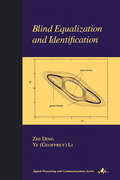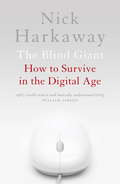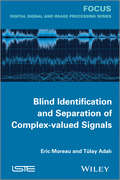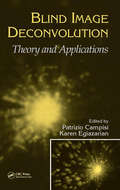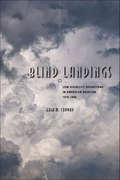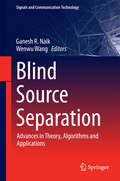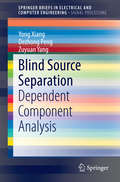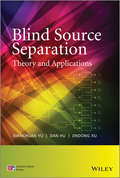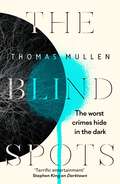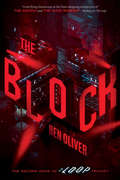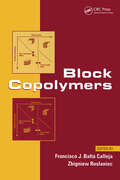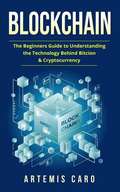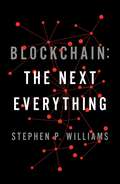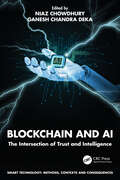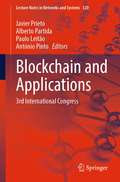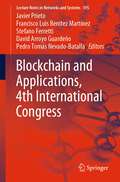- Table View
- List View
Blended Learning Solutions in Higher Education: History, Theory and Practice
by Neil HughesBlended Learning Solutions in Higher Education explores the origins, empirical foundations, and implementation of blended learning in colleges and universities. Since emerging as a third-way solution to traditional and virtual higher education models, blended learning has become a predominant learning modality in an era of rapid technological proliferation. Offering an alternative to longstanding yet flawed methodologies and assumptions about its validity, this book conceptualizes blended learning as a complex social practice mediated by knowledge, institutional rules, policies, and norms as well as material factors such as technology and physical spaces. The book’s original MIRACLE framework offers a research-grounded, highly practical guide to blended learning design, improvement, and long-term efficacy. From demystified history and heuristics to digitized platforms and course content to reimagined governance and regulations, these insights provide a thoughtful exemplar of blended learning’s challenges and affordances along with a firm basis for integrating face-to-face and online learning, teaching, and assessment innovatively and creatively.
Blending Indian Farmers' Traditional Knowledge in Agriculture with Modern Scientific Technologies: A Way Forward
by C. L. Acharya R. S. Chaudhary P. Gurumurthy A. Subba RaoThis book is a compilation of 37 chapters covering various agro ecosystems of India with respect to Indian farmers’ traditional knowledge and technology in agriculture specifically in nutrient management, crop production, water management and conservation, soil conservation and plant protection, which have been passed on from one generation to other since centuries. The book explains the scopes of blending this traditional knowledge with modern scientific technologies in agriculture with an aim of reducing production cost, improving soil health and use efficiency of costly market purchased inputs, water conservation and better environment. In the present era of continued degradation of natural resources of India, (primarily soil, water, and nutrients), falling soil health, poor use efficiency of agricultural inputs like fertilizer nutrients imported/ purchased at huge costs, it has become a big challenge to maintain the food production and simultaneously to sustain the soil health and productivity. The problem is further made complex by the changing climate, high levels of soil erosion and rising demands of ever-increasing population of the country for food, fodder, fibre, and fuel. In the face of such an alarming situation, the blending of low-cost traditional knowledge of Indian farmers and use of locally available inputs/ resources with the modern scientific technologies in agriculture, is seen as a major hope in increasing the input use efficiency, protection/conservation of the soil, water and nutrients towards sustainable crop production and food security without compromising the soil health. The book will be of interest to the scientists/researchers, extension workers, capacity builders, planners, government administrators, teachers, and students.
Blends and Graft Copolymers of Cellulosics: Toward the Design and Development of Advanced Films and Fibers (SpringerBriefs in Molecular Science)
by Yoshiyuki Nishio Yoshikuni Teramoto Ryosuke Kusumi Kazuki Sugimura Yoshitaka AranishiThis book reveals how polymer blending and grafting now offer a growing range of new applications for advanced films and fibers. Further, it details how the processing and original physical properties of cellulosics can be improved, and demonstrates how new, cellulose-core polymeric materials offer a wide range of synergistic functionalities. Lastly, it summarizes basic characterization studies and successful fabrications of advanced films and fibers. The book is primarily intended for advanced undergraduates, academic and industrial researchers and professionals studying or using bio-based polymers.
Blight
by Alexandra DuncanWhen an agribusiness facility producing genetically engineered food releases a deadly toxin into the environment, seventeen-year-old Tempest Torres races to deliver the cure before time runs out.From the author of the acclaimed American Booksellers Association’s Indies Introduce pick Salvage, which was called “Brilliant, feminist science fiction” by Stephanie Perkins, the internationally bestselling author of Anna and the French Kiss. This stand-alone action-adventure story is perfect for fans of Oryx and Crake and The House of the Scorpion. Seventeen-year-old Tempest Torres has lived on the AgraStar farm north of Atlanta, Georgia, since she was found outside its gates at the age of five. Now she’s part of the security force guarding the fence and watching for scavengers—people who would rather steal genetically engineered food from the Company than work for it. When a group of such rebels accidentally sets off an explosion in the research compound, it releases into the air a blight that kills every living thing in its path—including humans. With blight-resistant seeds in her pocket, Tempest teams up with a scavenger boy named Alder and runs for help. But when they finally arrive at AgraStar headquarters, they discover that there’s an even bigger plot behind the blight—and it’s up to them to stop it from happening again.Inspired by current environmental issues, specifically the genetic adjustment of seeds to resist blight and the risks of not allowing natural seed diversity, this is an action-adventure story that is Margaret Atwood’s Oryx and Crake meets Nancy Farmer’s House of the Scorpion.
Blind Equalization and Identification (Signal Processing and Communications)
by Zhi Ding Ye LiThis text seeks to clarify various contradictory claims regarding capabilities and limitations of blind equalization. It highlights basic operating conditions and potential for malfunction. The authors also address concepts and principles of blind algorithms for single input multiple output (SIMO) systems and multi-user extensions of SIMO equalization and identification.
The Blind Giant: How to Survive in the Digital Age
by Nick HarkawayThe digital age. An age of isolation, warped communication, disintegrating community. Where unfiltered and unregulated information pours relentlessly into our lives, destroying what it means to be human. Or an age of marvels. Where there is a world of wonder at our fingertips. Where we can communicate across the globe, learn in the blink of an eye, pull down the barriers that divide us and move forward together. Whatever your reaction to technological culture, the speed with which our world is changing is both mesmerising and challenging. In The Blind Giant, novelist and tech blogger Nick Harkaway draws together fascinating and disparate ideas to challenge the notion that digital culture is the source of all our modern ills, while at the same time showing where the dangers are real and suggesting how they can be combated. Ultimately, the choice is ours: engage with the machines that we have created, or risk creating a world which is designed for corporations and computers rather than people. This is an essential handbook for everyone trying to be human in a digital age.
The Blind Giant: How to Survive in the Digital Age
by Nick HarkawayThe digital age. An age of isolation, warped communication, disintegrating community. Where unfiltered and unregulated information pours relentlessly into our lives, destroying what it means to be human. Or an age of marvels. Where there is a world of wonder at our fingertips. Where we can communicate across the globe, learn in the blink of an eye, pull down the barriers that divide us and move forward together. Whatever your reaction to technological culture, the speed with which our world is changing is both mesmerising and challenging. In The Blind Giant, novelist and tech blogger Nick Harkaway draws together fascinating and disparate ideas to challenge the notion that digital culture is the source of all our modern ills, while at the same time showing where the dangers are real and suggesting how they can be combated. Ultimately, the choice is ours: engage with the machines that we have created, or risk creating a world which is designed for corporations and computers rather than people. This is an essential handbook for everyone trying to be human in a digital age.
Blind Identification and Separation of Complex-valued Signals
by Eric Moreau Tülay AdaliBlind identification consists of estimating a multi-dimensional system only through the use of its output, and source separation, the blind estimation of the inverse of the system. Estimation is generally carried out using different statistics of the output. The authors of this book consider the blind identification and source separation problem in the complex-domain, where the available statistical properties are richer and include non-circularity of the sources – underlying components. They define identifiability conditions and present state-of-the-art algorithms that are based on algebraic methods as well as iterative algorithms based on maximum likelihood theory. Contents 1. Mathematical Preliminaries. 2. Estimation by Joint Diagonalization. 3. Maximum Likelihood ICA. About the Authors Eric Moreau is Professor of Electrical Engineering at the University of Toulon, France. His research interests concern statistical signal processing, high order statistics and matrix/tensor decompositions with applications to data analysis, telecommunications and radar. Tülay Adali is Professor of Electrical Engineering and Director of the Machine Learning for Signal Processing Laboratory at the University of Maryland, Baltimore County, USA. Her research interests concern statistical and adaptive signal processing, with an emphasis on nonlinear and complex-valued signal processing, and applications in biomedical data analysis and communications. Blind identification consists of estimating a multidimensional system through the use of only its output. Source separation is concerned with the blind estimation of the inverse of the system. The estimation is generally performed by using different statistics of the outputs. The authors consider the blind estimation of a multiple input/multiple output (MIMO) system that mixes a number of underlying signals of interest called sources. They also consider the case of direct estimation of the inverse system for the purpose of source separation. They then describe the estimation theory associated with the identifiability conditions and dedicated algebraic algorithms. The algorithms depend critically on (statistical and/or time frequency) properties of complex sources that will be precisely described.
Blind Image Deconvolution: Theory and Applications
by Patrizio Campisi Karen EgiazarianBlind image deconvolution is constantly receiving increasing attention from the academic as well the industrial world due to both its theoretical and practical implications. The field of blind image deconvolution has several applications in different areas such as image restoration, microscopy, medical imaging, biological imaging, remote sensing, astronomy, nondestructive testing, geophysical prospecting, and many others. Blind Image Deconvolution: Theory and Applications surveys the current state of research and practice as presented by the most recognized experts in the field, thus filling a gap in the available literature on blind image deconvolution.Explore the gamut of blind image deconvolution approaches and algorithms that currently exist and follow the current research trends into the future. This comprehensive treatise discusses Bayesian techniques, single- and multi-channel methods, adaptive and multi-frame techniques, and a host of applications to multimedia processing, astronomy, remote sensing imagery, and medical and biological imaging at the whole-body, small-part, and cellular levels. Everything you need to step into this dynamic field is at your fingertips in this unique, self-contained masterwork.For image enhancement and restoration without a priori information, turn to Blind Image Deconvolution: Theory and Applications for the knowledge and techniques you need to tackle real-world problems.
Blind Landings: Low-Visibility Operations in American Aviation, 1918–1958
by Erik M. ConwayWhen darkness falls, storms rage, fog settles, or lights fail, pilots are forced to make "instrument landings," relying on technology and training to guide them through typically the most dangerous part of any flight. In this original study, Erik M. Conway recounts one of the most important stories in aviation history: the evolution of aircraft landing aids that make landing safe and routine in almost all weather conditions. Discussing technologies such as the Loth leader-cable system, the American National Bureau of Standards system, and, its descendants, the Instrument Landing System, the MIT-Army-Sperry Gyroscope microwave blind landing system, and the MIT Radiation Lab's radar-based Ground Controlled Approach system, Conway interweaves technological change, training innovation, and pilots' experiences to examine the evolution of blind landing technologies. He shows how systems originally intended to produce routine, all-weather blind landings gradually developed into routine instrument-guided approaches. Even so, after two decades of development and experience, pilots still did not want to place the most critical phase of flight, the landing, entirely in technology's invisible hand. By the end of World War II, the very concept of landing blind therefore had disappeared from the trade literature, a victim of human limitations.
Blind Source Separation: Advances in Theory, Algorithms and Applications (Signals and Communication Technology)
by Ganesh R. Naik Wenwu WangBlind Source Separation intends to report the new results of the efforts on the study of Blind Source Separation (BSS). The book collects novel research ideas and some training in BSS, independent component analysis (ICA), artificial intelligence and signal processing applications. Furthermore, the research results previously scattered in many journals and conferences worldwide are methodically edited and presented in a unified form. The book is likely to be of interest to university researchers, R&D engineers and graduate students in computer science and electronics who wish to learn the core principles, methods, algorithms and applications of BSS. Dr. Ganesh R. Naik works at University of Technology, Sydney, Australia; Dr. Wenwu Wang works at University of Surrey, UK.
Blind Source Separation: Dependent Component Analysis (SpringerBriefs in Electrical and Computer Engineering)
by Yong Xiang Dezhong Peng Zuyuan YangThis book provides readers a complete and self-contained set of knowledge about dependent source separation, including the latest development in this field. The book gives an overview on blind source separation where three promising blind separation techniques that can tackle mutually correlated sources are presented. The book further focuses on the non-negativity based methods, the time-frequency analysis based methods, and the pre-coding based methods, respectively.
Blind Source Separation: Theory and Applications
by Xianchuan Yu Dan Hu Jindong XuA systematic exploration of both classic and contemporary algorithms in blind source separation with practical case studies The book presents an overview of Blind Source Separation, a relatively new signal processing method. Due to the multidisciplinary nature of the subject, the book has been written so as to appeal to an audience from very different backgrounds. Basic mathematical skills (e.g. on matrix algebra and foundations of probability theory) are essential in order to understand the algorithms, although the book is written in an introductory, accessible style. This book offers a general overview of the basics of Blind Source Separation, important solutions and algorithms, and in-depth coverage of applications in image feature extraction, remote sensing image fusion, mixed-pixel decomposition of SAR images, image object recognition fMRI medical image processing, geochemical and geophysical data mining, mineral resources prediction and geoanomalies information recognition. Firstly, the background and theory basics of blind source separation are introduced, which provides the foundation for the following work. Matrix operation, foundations of probability theory and information theory basics are included here. There follows the fundamental mathematical model and fairly new but relatively established blind source separation algorithms, such as Independent Component Analysis (ICA) and its improved algorithms (Fast ICA, Maximum Likelihood ICA, Overcomplete ICA, Kernel ICA, Flexible ICA, Non-negative ICA, Constrained ICA, Optimised ICA). The last part of the book considers the very recent algorithms in BSS e.g. Sparse Component Analysis (SCA) and Non-negative Matrix Factorization (NMF). Meanwhile, in-depth cases are presented for each algorithm in order to help the reader understand the algorithm and its application field. A systematic exploration of both classic and contemporary algorithms in blind source separation with practical case studies Presents new improved algorithms aimed at different applications, such as image feature extraction, remote sensing image fusion, mixed-pixel decomposition of SAR images, image object recognition, and MRI medical image processing With applications in geochemical and geophysical data mining, mineral resources prediction and geoanomalies information recognition Written by an expert team with accredited innovations in blind source separation and its applications in natural science Accompanying website includes a software system providing codes for most of the algorithms mentioned in the book, enhancing the learning experience Essential reading for postgraduate students and researchers engaged in the area of signal processing, data mining, image processing and recognition, information, geosciences, life sciences.
The Blind Spots: The highly inventive near-future detective mystery from the acclaimed author of Darktown
by Thomas MullenFrom the acclaimed author of Darktown comes the most inventive crime novel since Minority Report.'It's rare to find a thriller with such a fantastic and original concept. I was gripped' --- Anthony HorowitzIn a world where a global event has blinded every person on the planet, one detective seeks a murderer who should not, cannot, exist.Seven years ago, everyone in the world went blind in a matter of months. Technology helped people adjust to the new normal, creating a device that approximates vision, downloading visual data directly to people's brains. But what happens when someone finds a way to manipulate it and change what people see?Homicide detective Mark Owens has been on the force since before The Blinding. When a scientist is murdered, and the only witness insists the killer was blacked out of her vision, Owens doesn't believe her - until a similar murder happens in front of him. With suspects ranging from tech billionaires to anti-modernity cultists, Owens must conduct an investigation in which he can't even trust his own eyes...PRAISE FOR THOMAS MULLEN'Terrific entertainment' - Stephen King'Superb' - Ken Follett'Magnificent and shocking' - Sunday Times'Written with a ferocious passion that'll knock the wind out of you' - New York Times'Fascinating, grim and unsettling' - Guardian'A terrific story' - The Times'From the very first page of Darktown, I was stunned, mesmerized' - Attica Locke
Blip, Ping, and Buzz: Making Sense of Radar and Sonar
by Mark DennyHave you ever wondered how stealth planes achieve "invisibility," how sunken ships are found, or how fishermen track schools of fish in vast expanses of ocean? Radar and sonar echolocation—a simple matter of sending, receiving, and processing signals.Weaving history with simple science, Mark Denny deftly reveals the world of radar and sonar to the curious reader, technology buff, and expert alike. He begins with an early history of the Chain Home radar system used during World War II and then provides accessible and engaging explanations of the physics that make signal processing possible. Basic diagrams and formulas show how electromagnetic and sound waves are transmitted, received, and converted into images, allowing you to literally see in the dark.A section on bioacoustic echolocation, with a focus on the superior sonar systems of bats and whales and a discussion of the advanced technology of next-generation airborne signal processors, opens the imagination to fascinating possibilities for the future.
The Block (The Loop)
by Ben OliverIn the second book of The Loop trilogy, Luka is trapped in a fate worse than death. But now that he knows the truth about what he and his fellow inmates are being used for, it's more important than ever that he not only escapes, but that he builds an army.Luka is a prisoner once again. But this time it's a fate worse than death. In the Block, he must toggle between enduring an Energy Harvest for twelve hours of the day and surviving complete immobilization. The only semblance of relief is the Sane Zone, created to keep prisoners from going completely mad. In this virtual reality, the prisoners live out their fantasies of life outside. But for Luka, it's different.Happy is determined to find out the location of his friends, who disappeared after the Battle of Midway Park. But can Luka battle the descent into madness long enought to stop Happy's manipulation tactics and keep his friends' location safe?Another prison break is the only chance to protect the Missing. And as reality becomes increasingly scrambled on the outside, it'll take an army to stop Galen from carrying out his plans.
Block Co-polymeric Nanocarriers: Design, Concept, and Therapeutic Applications
by Neeraj Mishra Vikas PandeyThis book focuses on current advancements in the field of block copolymers and covers design, concept, and various therapeutic applications in the drug delivery. It also reviews the use of block copolymers in drug delivery applications from the development of sustained release products to smart polymeric delivery systems such as stimuli-responsive polymeric systems, for example, thermosensitive, redox-sensitive, photo-sensitive, and enzyme-sensitive. The book further discusses the nano assemblies from amphiphilic block copolymers as nanomedicine platforms for diagnosis and therapy due to their relatively small size, high drug loading capacity, controlled drug release, in vivo stability, and prolonged blood circulation. The chapters also review the various patents and ongoing clinical trials on the applications, covering several important new concepts and findings in the field of block copolymers. The book is aimed at researchers, academicians, and industrial scientists involved in the development of drug-delivery systems based on polymers.
Block Copolymers
by Francisco J. Baltá Calleja Zbigniew RoslaniecA summary of block copolymer chemical structures and synthesis. It discusses physical methods of characterization such as computer simulation, microhardness, dielectric spectroscopy, thermal mechanical relaxation, ultrasonic characterization, transmission electron microscopy, X-ray scattering, and NMR, among others. It also outlines rheological and
Blockchain: The Beginners Guide To Understanding The Technology Behind Bitcoin And Cryptocurrency
by Artemis CaroCryptocurrency and it's disruptive architecture, Blockchain, is now making the biggest revolution in the Finance sector for the last 100 years. There is a lot of hype surrounding the concept of the blockchain, but what does this term actually mean? What is blockchain technology? Why does it matter? These questions are not always answered with due diligence in the sea of headlines that deal with digital currencies using blockchains. As a result, many people are left with an incomplete understanding of this transformative new technology and its massive implications for the future. The goal of this book is not to plumb the depths of the mathematical wizardry used to code blockchain-based applications, but rather to serve as an introduction to the broader architecture and conceptual background behind blockchain technology. We will take a practical approach, examining how Blockchains are used in the real world. In this short, concise guide you will learn: A Brief History of Blockchain Technology Blockchain Basics: Managing Digital Transactions What is a Distributed Ledger? Blockchain Beyond Bitcoin Implications Of Blockchain: Big Data, Privacy & Personal Data Profiting from Blockchain Technologies Limitations & Challenges of Blockchain The Future of Blockchain For Centuries, people have relied on corrupt Centralized Institutions like banks and Governments to serve as intermediaries when it comes to storing and transacting financial assets.
Blockchain: Grundlagen, Anwendungsszenarien und Nutzungspotenziale (Edition HMD)
by Andreas Meier Hans-Georg FillSowohl in der Praxis als auch der wissenschaftlichen Forschung ist das Thema "Blockchain" aktuell von großem Interesse. Noch scheint sich die Technologie am Anfang ihrer Entwicklung zu befinden: Plattformen wie Bitcoin, Ethereum, Hyperledger Fabric, Libra, TradeLens oder andere weisen bereits einen beeindruckenden Reifegrad in ihrer technischen Entwicklung auf. Dennoch befinden sich erst wenige von ihnen bzw. darauf aufbauende Applikationen im produktiven Einsatz bei Unternehmen. Hier können nicht nur Forschende optimal dazu beitragen, neue Ideen zu entwickeln, noch nicht betrachtete Anwendungsfälle und -domänen zu untersuchen und erste Prototypen für den konkreten Einsatz zu entwickeln. Die Beiträge der vorliegenden Edition HMD bieten dazu einen umfassenden Überblick und zeigen die große Bandbreite an möglichen Anwendungsfeldern für Blockchains. Das Herausgeberwerk vermittelt somit die Grundlagen zur Blockchain-Technologie, widmet sich den Smart Contracts und beschreibt wichtige Anwendungsszenarien, erste Fallbeispiele und rechtliche Aspekte. Wie typisch für die Fachbuchreihe Edition HMD greifen die Beitragsautoren das Thema aus Sicht von Forschung und Praxis gleichermaßen auf. Ein Glossar mit den wichtigsten Begriffen rundet das Buch ab.
Blockchain: A Short Guide To Blockchain
by Stephen P. WilliamsAn experienced tech writer fully explains blockchain technology and how it will radically transform the world as we know it in this accessible, reader-friendly, illuminating guide.What is blockchain? Why does everyone from tech experts to business moguls to philanthropists believe it is a paradigm-shifting technology, bound to revolutionize society as significantly as the internet? Indeed, why is blockchain touted as The Next Everything? In this deft, fascinating, and easy-to-digest introduction to one of the most important innovations of recent times, Stephen P. Williams answers these questions, revealing how cryptocurrencies like bitcoin are just one example among dozens of transformative applications that this relatively new technology makes possible. He interprets the complexity into digestible anecdotes, metaphors, and straightforward descriptions for readers who don’t know tech, and explains all of blockchain’s most important aspects: why this so-called digital ledger is unhackable and unchangeable; how its distributed nature may transfer power from central entities like banks, government, and corporations to ordinary citizens around the world; and what its widespread use will mean for society as a whole. Taking us on a dazzlingly vivid tour through the systems predicted to soon underpin economics, politics, global trade, science, art, and numerous other aspects of our everyday lives, Blockchain: The Next Everything is a truly extraordinary journey into our future.
Blockchain and AI: The Intersection of Trust and Intelligence (Smart Technology)
by Niaz Chowdhury Ganesh Chandra DekaIn the rapidly evolving landscape of the digital age, two technologies stand out for their transformative potential: Artificial Intelligence (AI) and Blockchain. This book offers an incisive exploration of the confluence between these technological titans, shedding light on the synergies, challenges, and innovations that arise at this intersection. The chapters explore thought-provoking analyses, informed by cutting-edge research and expert perspectives, that navigate the nuanced interplay of decentralized ledger technology and intelligent systems. From potential applications in teaching and learning, finance, healthcare, and governance to ethical considerations and future trajectories, this volume serves as an essential compendium for scholars, professionals, and anyone keen to grasp the future of digital innovation.
Blockchain and Applications: 3rd International Congress (Lecture Notes in Networks and Systems #320)
by Javier Prieto Alberto Partida Paulo Leitão António PintoThis book constitutes the refereed proceedings of the 1st International Congress on Blockchain and Applications 2021, BLOCKCHAIN’21, held in Salamanca, Spain, in October 2021. Among the scientific community, blockchain and artificial intelligence are a promising combination that will transform the production and manufacturing industry, media, finance, insurance, e-government, etc. Nevertheless, there is no consensus with schemes or best practices that would specify how blockchain and artificial intelligence should be used together. The 38 full papers presented were carefully reviewed and selected from over 44 submissions. They contain the latest advances on blockchain and artificial intelligence and on their application domains, exploring innovative ideas, guidelines, theories, models, technologies, and tools and identifying critical issues and challenges that researchers and practitioners must deal with in future research.
Blockchain and Applications: 2nd International Congress (Advances in Intelligent Systems and Computing #1238)
by Javier Prieto António Pinto Ashok Kumar Das Stefano FerrettiThis book constitutes the refereed proceedings of the 1st International Congress on Blockchain and Applications 2020, BLOCKCHAIN’20, held in L’Aquila, Italy, in October 2020. Among the scientific community, blockchain and artificial intelligence are a promising combination that will transform the production and manufacturing industry, media, finance, insurance, e-government, etc. Nevertheless, there is no consensus with schemes or best practices that would specify how blockchain and artificial intelligence should be used together. The 21 full papers presented were carefully reviewed and selected from over 40 submissions. They contain the latest advances on blockchain and artificial intelligence and on their application domains, exploring innovative ideas, guidelines, theories, models, technologies, and tools, and identifying critical issues and challenges that researchers and practitioners must deal with in future research.
Blockchain and Applications, 4th International Congress (Lecture Notes in Networks and Systems #595)
by Javier Prieto Francisco Luis Benítez Martínez Stefano Ferretti David Arroyo Guardeño Pedro Tomás Nevado-BatallaThis book constitutes the refereed proceedings of the 4th International Congress on Blockchain and Applications 2022, BLOCKCHAIN’22, held in L’Aquila, Italy, in July 2022. Among the scientific community, blockchain and artificial intelligence are a promising combination that will transform the production and manufacturing industry, media, finance, insurance, e-government, etc. Nevertheless, there is no consensus with schemes or best practices that would specify how blockchain and artificial intelligence should be used together.The 37 full papers presented in the main track were carefully reviewed and selected from more than 75 submissions. They contain the latest advances on blockchain and artificial intelligence and on their application domains, exploring innovative ideas, guidelines, theories, models, technologies, and tools and identifying critical issues and challenges that researchers and practitioners must deal with in the future research. The book also includes 3 papers from the WEB3-TRUST workshop and 2 papers from the Doctoral Consortium.




